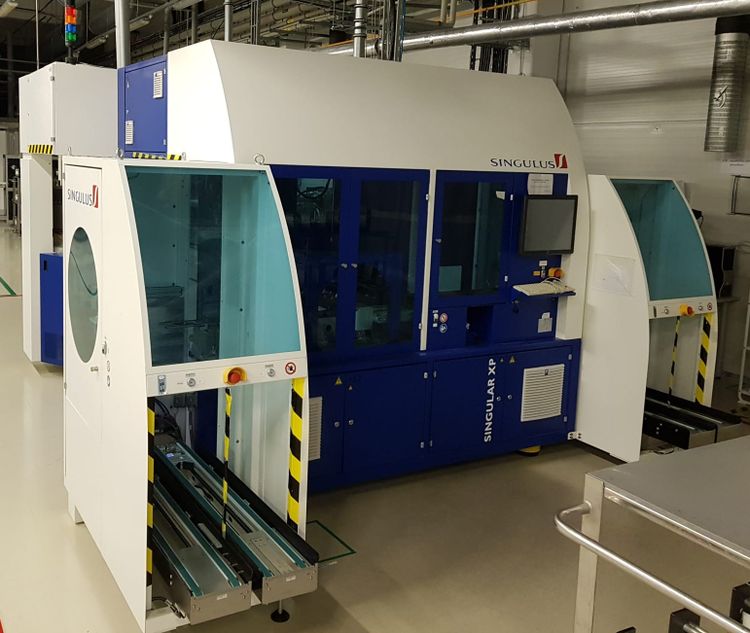3 Singulus XP
AMERICA North (USA-Canada-Mexico)
ICP PECVD system for solar cells production
Version: Solar
Vintage: 01.06.2015
-STILL INSTALLED. IN EXCELLENT CONDITION WITH
NO KNOWN MISSING OR BROKEN PARTS.
-CAN BE INSPECTED BY APPOINTMENT.
-PLEASE REFER TO ATTACHED PHOTOS FOR
DETAILS ABOUT CURRENT INSTALLATION CONDITION AND
PHOTOS.
The Singulus SINGULAR ICP-PECVD is a
fully automated innovative and modular PECVD coating tool for
R&D and pilot production of crystalline silicon solar cells.
The SINGULAR system is designed for
making passivation layers for high-effciency solar cells
following conventional and new cell concepts, e.g.
heterojunction solar cells.
The SINGULAR system is made up of an automation module
and a coating module. The coating module consists of
several customizable vacuum chambers.
It allows the coating of complex layers, such as
layer stacks of different materials e. g. AlOx/SiNy.
The key feature of the tool is the ICP-PECVD technology.
The inductively coupled plasma (ICP) excitation allows control
of film properties for various materials such as SiNx, AlOx,
SiOxNy at high deposition rates.
The process variability, the small tool footprint in
combination with an excellent total ”Cost Of Ownership“ makes
SINGULAR ideally suitable for upgrades of
existing production lines.
SINGULAR allows developing new manufacturing processes for
cell efficiencies above 20 % .
Therewith, SINGULUS makes a valuable contribution to
continuous improvements with respect to efficiency and
manufacturing cost of PV modules, being a necessity to
reduce the costs and enable the large-scale deployment of
PV electricity.
Main Features:
Industrial proven multi-chamber ICP-PECVD coating tool
Lowest cost of ownership
Modular design for various processes (e. g. SiNx, SiOxNy, AlOx, a-Si ...)
Single- and multi-layer capability
Double-side coating capability
Small footprint
Integrated electrical and gas cabinets
Efficient use of raw materials like electrical power, process gases ...
Low noise level (no grey room necessary)
High uptime
Easy to operate
Easy to maintain
Inline cleaning processes available (e. g. for a-Si)
Customized tool configuration, e. g. usage of special gases e. g. TMB, phosphine, organic precursors like TMAl
Integrated automation solution
Inline and cluster operation possible
All types of automation cassettes suitable
Main Characteristics
SINGULAR XP
Cluster Setup
The SINGULAR XP series is equipped with
an integrated automation unit,
which allows loading automation carriers into the system.
After processing the wafers are also stored into an
automation carrier. The SINGULAR XP is executed with
two magazine conveyor stations.
Each station can store up to 5 filled and
5 empty automation carriers (magazine).
The wafers are unloaded from this magazine and
stored after processing back into a magazine.
Typical magazines and automation cassettes are available.
SINGULAR Platform Technology
SINGULAR is a fully automated coating tool designed for
the mass production of silicon solar cells. It consists of
one coating module with up to five independent vacuum
process stations. This modular design makes it possible to
adapt the tool setup individually to process demands and
cell concepts. The SINGULAR platform is equipped with
a single load lock. The load lock meets two functions,
first bringing the uncoated wafers from ambient air
environment into a high vacuum chamber with
a base pressure below 10-5 mbar and second ejecting the
coated wafers from the system.
Inside the main vacuum chamber, the wafers follow an
in-line setup throughout every process station (PS1-PS5).
Each process station can be equipped with different processes,
like IR heating or ICP-PECVD.
New Cell Processes with SINGULAR XP for High-efficiency Cells
The SINGULAR XP platform is applied at research centers and
institutes in Europe, North America and Asia in
different configurations.
The involved R&D teams take advantage of the flexibility of
the SINGULAR to perform industry orientated R&D as well as
to advanced application orientated basic research to
further improve the efficiency of solar energy conversion.
Current major topics are rear side passivated cells (PERC type)
and heterojunction cells.
The target is to develop a sustainable energy supply based on solar resources.

